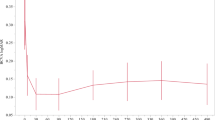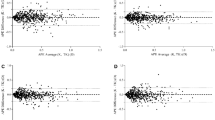Abstract
Aims
To determine the incidence of postkeratoplasty intraocular pressure (IOP) elevation in the eyes of subjects with keratoconus and establish the relationship between IOP and corticosteroid administrations in this population.
Methods
Following strict inclusion/exclusion criteria, a retrospective analysis was performed on a consecutive series of penetrating keratoplasties performed for keratoconus observing a standardised surgical and postoperative regimen in Auckland, New Zealand. Patient demographics, ocular, medical, and family history, and pre- and postoperative data were recorded until 12 months postkeratoplasty.
Results
In all, 57 eyes of 48 patients were included—31% New Zealand Europeans, 42% Pacific people, 15% Maori, and 12% other. Eighteen eyes (32%) of 17 patients (35%) exhibited elevated IOP and 12 (21%) eyes exhibited moderate-to-severe elevation of IOP. IOP elevation occurred 3–6 months postkeratoplasty in 78% of eyes. Elevated IOP was significantly less common in Maori and Pacific peoples (P=0.02). All eyes except one required reduction/cessation of corticosteroids to normalise IOP.
Conclusions
The incidence of presumed steroid-related postkeratoplasty IOP elevation, in 35% of subjects with keratoconus, is markedly higher in this New Zealand study than previously reported in the US and UK studies. Further clinical and genetic analysis of associations between keratoconus and steroid-induced IOP elevation and glaucoma might improve our current understanding of this condition.
Similar content being viewed by others
Log in or create a free account to read this content
Gain free access to this article, as well as selected content from this journal and more on nature.com
or
References
Francois J . Cortisone et tension oculaire. Ann D'Oculist 1954; 187: 805.
Kwok AK, Lam DS, Ng JS, Fan DS, Chew SJ, Tso MO . Ocular-hypertensive response to topical steroids in children. Ophthalmology 1997; 104: 2112–2116.
Kirkness CM, Ficker LA . Risk factors for the development of postkeratoplasty glaucoma. Cornea 1992; 11: 427–432.
Charlin R, Polack FM . The effect of elevated intraocular pressure on the endothelium of corneal grafts. Cornea 1982; 1: 241–249.
Irvine AR, Kaufman HE . Intraocular pressure following penetrating keratoplasty. Am J Ophthalmol 1969; 68: 835–844.
Edwards M, Clover GM, Brookes N, Pendergrast D, Chaulk J, McGhee CN . Indications for corneal transplantation in New Zealand: 1991–1999. Cornea 2002; 21: 152–155.
The Australian Corneal Graft Registry. 1990 to 1992 Report. Aust N Z J Ophthalmol 1993; 21: 1–48.
Sihota R, Sharma N, Panda A, Aggarwal HC, Singh R . Post-penetrating keratoplasty glaucoma: risk factors, management and visual outcome. Aust N Z J Ophthalmol 1998; 26: 305–309.
Wilson SE, Kaufman HE . Graft failure after penetrating keratoplasty. Surv Ophthalmol 1990; 34: 325–356.
Chien AM, Schmidt CM, Cohen EJ, Rajpal RK, Sperber LT, Rapuano CJ et al. Glaucoma in the immediate postoperative period after penetrating keratoplasty. Am J Ophthalmol 1993; 115: 711–714.
Goldberg DB, Schanzlin DJ, Brown SI . Incidence of increased intraocular pressure after keratoplasty. Am J Ophthalmol 1981; 92: 372–377.
Jonas JB, Rank RM, Hayler JK, Budde WM . Intraocular pressure after homologous penetrating keratoplasty. J Glaucoma 2001; 10: 32–37.
Simmons RB, Stern RA, Teekhasaenee C, Kenyon KR . Elevated intraocular pressure following penetrating keratoplasty. Trans Am Ophthalmol Soc 1989; 87: 79–91, (discussion 91–3).
Kirkness CM, Moshegov C . Post-keratoplasty glaucoma. Eye 1988; 2 (Suppl): S19–S26.
Armaly MF . Effect of corticosteroids on intraocular pressure and fluid dynamics. Ii. the effect of dexamethasone in the glaucomatous eye. Arch Ophthalmol 1963; 70: 492–499.
Becker B, Mills DW . Corticosteroids and intraocular pressure. Arch Ophthalmol 1963; 70: 500–507.
Becker B . Intraocular pressure response to topical corticosteroids. Invest Ophthalmol 1965; 4: 198–205.
Goodman WT, Mathers WD, Munden PM, Ossoinig KC, Daley TE . A study of aqueous humor dynamics in keratoconus. Exp Eye Res 1996; 62: 95–99.
Edwards M, McGhee CN, Dean S . The genetics of keratoconus. Clin Experiment Ophthalmol 2001; 29: 345–351.
Wiggs JL . Genetic etiologies of glaucoma. Arch Ophthalmol 2007; 125: 30–37.
Seitz B, Langenbucher A, Nguyen NX, Kuchle M, Naumann GO . Long-term follow-up of intraocular pressure after penetrating keratoplasty for keratoconus and Fuchs' dystrophy: comparison of mechanical and Excimer laser trephination. Cornea 2002; 21: 368–373.
Nguyen NX, Seitz B, Martus P, Langenbucher A, Cursiefen C . Long-term topical steroid treatment improves graft survival following normal-risk penetrating keratoplasty. Am J Ophthalmol 2007; 144: 318–319.
Lewis JM, Priddy T, Judd J, Gordon MO, Kass MA, Kolker AE et al. Intraocular pressure response to topical dexamethasone as a predictor for the development of primary open-angle glaucoma. Am J Ophthalmol 1988; 106: 607–612.
Kitazawa Y, Horie T . The prognosis of corticosteroid-responsive individuals. Arch Ophthalmol 1981; 99: 819–823.
Acknowledgements
We thank Joanna Stewart (biostatistician), and Shalina Navaratnam (medical student) for their input into this study.
Author information
Authors and Affiliations
Corresponding author
Rights and permissions
About this article
Cite this article
Fan, J., Chow, K., Patel, D. et al. Corticosteroid-induced intraocular pressure elevation in keratoconus is common following uncomplicated penetrating keratoplasty. Eye 23, 2056–2062 (2009). https://doi.org/10.1038/eye.2008.413
Received:
Revised:
Accepted:
Published:
Issue date:
DOI: https://doi.org/10.1038/eye.2008.413
Keywords
This article is cited by
-
The effect of loteprednol suspension eye drops after corneal transplantation
BMC Ophthalmology (2021)
-
Dexamethasone/prednisolone acetate
Reactions Weekly (2018)



